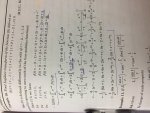I am also not certain what it is you are asking about. Is it just the absolute value?
You are given that f(x)= |x- 1|+ |x+ 1|+ |x- 2|+ |x+ 2|
|a| is defined as "a if \(\displaystyle a\ge 0\), -a if \(\displaystyle a< 0\)".
So |x- 1| is x- 1 if \(\displaystyle x- 1\ge 0\), which is the same as saying \(\displaystyle x\ge 1\), -(x- 1)= 1- x if \(\displaystyle x< 1\).
|x+ 1| is x+ 1 if \(\displaystyle x+ 1\ge 0\), which is the same as saying \(\displaystyle x\ge -1\), -(x+ 1)= -x- 1 if \(\displaystyle x< -1\).
|x- 2| is x- 1 if \(\displaystyle x- 2\ge 0\), which is the same as saying \(\displaystyle x\ge 2\), -(x- 2)= 2- x if \(\displaystyle x< 2\).
|x+ 2|= x+ 2 if \(\displaystyle x+ 2\ge 0\), which is the same as saying \(\displaystyle x\ge -2\), -(x+ 2)= -x- 2 if \(\displaystyle x< -2\).
In order of size, those "break points", where the absolute value changes, are -2, -1, 1, and 2.
If x< -2, all four of x- 1, x+ 1, x- 2, and x+ 2 are negative so that sum of absolute values is (1- x)+ (-x- 1)+ (2- x)+ (-x- 2)= -4x.
If \(\displaystyle -2\le x< -1\), x+ 2 is positive but x- 1, x+ 1, and x- 2 are still negative so the sum is (1- x)+ (-x-1)+ (2- x)+ (x+2)= -2x+ 4.
If \(\displaystyle -1\le x< 1\), x+ 2 and x+ 1 are positive but x- 1 and x- 2 are still negative so the sum is (1- x)+ (x+ 1)+ (2- x)+ (x+ 2)= 6.
If \(\displaystyle 1\le x< 2\), x+ 2, x+ 1, and x- 1 are positive but x- 2 is still negative so the sum is (x- 1)+ (x+ 1)+ (2- x)+ x+ 2= 2x+ 4.
If \(\displaystyle 2\le x\) all four of x+ 2, x+ 1, x- 1, and x- 2 are positive so the sum is (x- 1)+ (x+ 1)+ (x- 2)+ (x+ 2)= 4x.

